Commodore Leslie Gehres, Date Unknown (Source: Woodling)
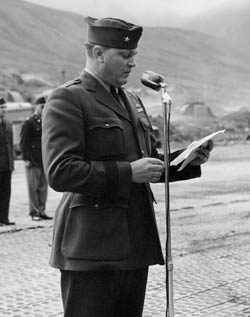 |
Leslie Gehres landed once at Tucson, Monday, August 19, 1929. He flew an unidentified Boeing F2B. Based at San Diego, CA aboard the U.S.S. Saratoga, he arrived amidst nineteen other naval aviators, each signed into the Register on the middle third of page 112 by an unknown hand. Please direct your browser to the link and review page 112. There you'll see that signers Tate through Wick comprised the nineteen. They all remained overnight at Tucson, departing the next morning for El Paso, TX.
Charleston, WV Gazette, August 25, 1929 (Source: Woodling)
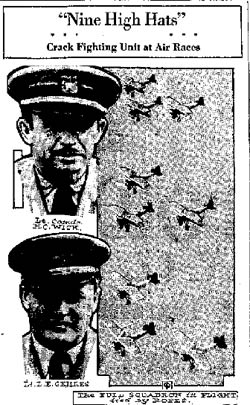 |
What were they doing at Tucson? They were headed for Cleveland, OH and the National Air Races (NAR) held August 24-September 2 that year. Gehres was as part of an entire squadron of Navy aircraft under the command of Lt. Cdr. Homer Wick that passed through Tucson August 19th. Please direct your browser to Wick's page for details around his grand cross-country command.
The Charleston (WV) Gazette of Sunday, August 25, 1929 carried a syndicated article describing the "Nine High Hats." At right, the photograpic part of the article that shows Homer Wick, commanding officer of Squadron No. 1 based on the Saratoga, and Lt. Gehres juxtaposed with the High Hats. Please direct your browser to Lt. Cdr. Wick's page for details around this significant, for the time, cross-country logistical exercise.
The "Nine High Hats" were made up from fighting plane Squadron No. 1. The group was cited as the "... crack combat organization of the navy." One of their sensational feats was all nine aircraft performing loops in three sections while each section was tied together at their wingtips by 3/4" ropes 400 feet long.
According to the article, Gehres was leader of the first section of three, which included wingmen Frank O'Bierne and Frederick Kivette. The second section was headed by J.R. Tate with wingmen C.W. McClusky and W.M. McMullen. The third section was led by F.C. Sutton with wingmen C.K. Lankford and G.T. Mundorff.
All these pilots are pictured in the photograph below, in section order. Gehres is circled with O'Bierne and Kivette standing behind him, left to right, respectively. This is an Official U.S. Navy Photograph, now in the collections of the U.S. National Archives. The airplane is identified as a Boeing F2B-1. Further details about the High Hats and the pilots can be acquired through hyperlinks installed at Homer Wick's page.
The "Nine High Hats," Gehres Circled, August 16, 1929 (Source: NHH via Bob Woodling)
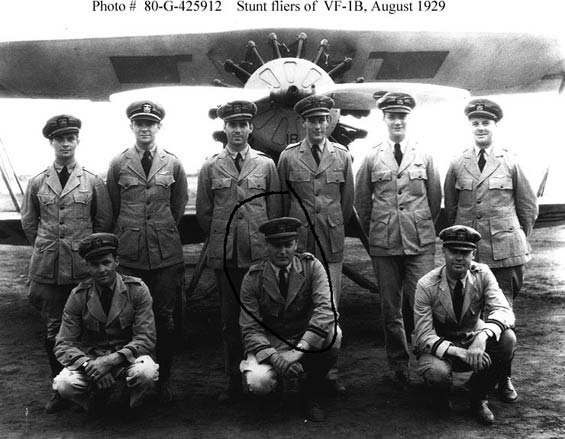 |
This wasn't the first time the navy was repesented at the NAR. The team calling themselves the "Three Sea Hawks" performed at the 1928 NAR. This team of three consisted of William V. Davis, Jr., D.W. Tomlinson and A.P. Storrs. Tomlinson and Storrs are Register pilots. Davis flew as the navigator for the first non-military flight across the Pacific Ocean in 1927 with Art Goebel.
During WWII Gehres performed from the ice in Alaska to the fire in the Pacific. He and his men received many decorations for their actions in the air and on the sea. Despite the decorations, Gehres may not have been well-liked by his subordinates, as indicated in the brief biography at the link. During 1943, he was based in Alaska. Photograph, below, shows him as Commodore with his fellow officers and men at that station.
Gehres (Center) In Alaska (Source: Woodling)
 |
Note the PBY aircraft behind them, and the next article from the January 10, 1943 issue of The New York Times.
Gehres in Alaska, The New York Times, January 10, 1943 (Source: NYT)
 |
Later, Gehres was captain of the U.S.S. Franklin, an aircraft carrier on duty near the coast of Japan. Aboard the Franklin, known as "THE SHIP THAT WOULD NOT DIE," Gehres and his men endured a literal trial by fire in March, 1945. The article and photographs below from The New York Times of May 18, 1945 are self-explanatory. This incident, and the repair and return to duty of the Franklin, is one of the enduring sagas of WWII. Gehres became somewhat of a celebrity, being asked to participate in fund raisers and other activities in support various activities before and after the end of WWII. Another article appeared in The New York Times on the same day ("Carrier Wrecked by Bombs Gets Home Despite Big Loss").
The New York Times, May 18, 1945 (Source: NYT via Bob Woodling)
 |
Below, the photographs from the May 18th article. The Franklin was struck at 7:07AM on March 19, 1945. It made way under its own power to Brooklyn, NY for repairs by May, stopping in Hawaii on the way for temporary repairs. In the end, the hit on Franklin killed over 800 and wounded over 250. She was not repaired in time to return to combat before the end of the war. She was eventually decommissioned and rendered as scrap in the mid-1960s.
The New York Times, May 18, 1945 (Source: NYT via Bob Woodling)
 |
Among his men, however, Gehres still remained unpopular. Among the reasons for his unpopularity had to do with about a hundred men who were blown out of their gun tubs or had jumped off the fantail of the Franklin with fire at their backs. They were furious when they returned to the Franklin for its journey to repair. Gehres wrote a letter to each of them asking them to justify their "desertion" when no order had been given to abandon ship. Gehres promised charges and courts-martial for the "deserters." Navy brass never processed the charges. Rightly so, the Franklin men stood divided on Gehres: a strong-willed captain or a career-obsessed egomaniac.
Leslie Gehres Being Decorated by Admiral Fletcher, Ca. 1945 (Source: Woodling)
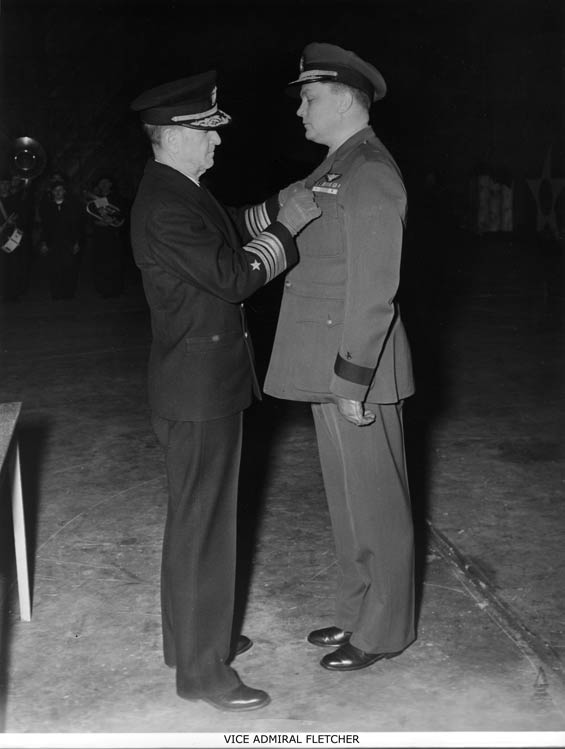 |
The Franklin had been struck earlier than the March 19th attack. The previous attack occurred off the Philippines late in October, 1944 during the battle for Leyte Gulf. Her airplanes were operating against Luzon, when a Japanese plane scored a direct hit on the flight deck resulting in serious fires that took two hours to control. Her airplanes were taken aboard other carriers. The Franklin returned to Bremerton, WA for repairs.
Below, Gehres in a formal portrait signed to Louis De Voe, "With sincere appreciation for a job superbly done."
Commodore Leslie Gehres, August 26, 1944 (Source: Woodling)
 |
Gehres ran for Congress as a Republican against incumbent Democrat Clinton McKinnon in California's 23rd District in 1950. McKinnon was reelected, 51% to Gehres' 49%. Below, a campaign poster used by Gehres, which leveraged his war record and displayed an image of the distressed Franklin.
L.E. Gehres, Congressional Campaign Poster, 1940 (Source: Woodling)
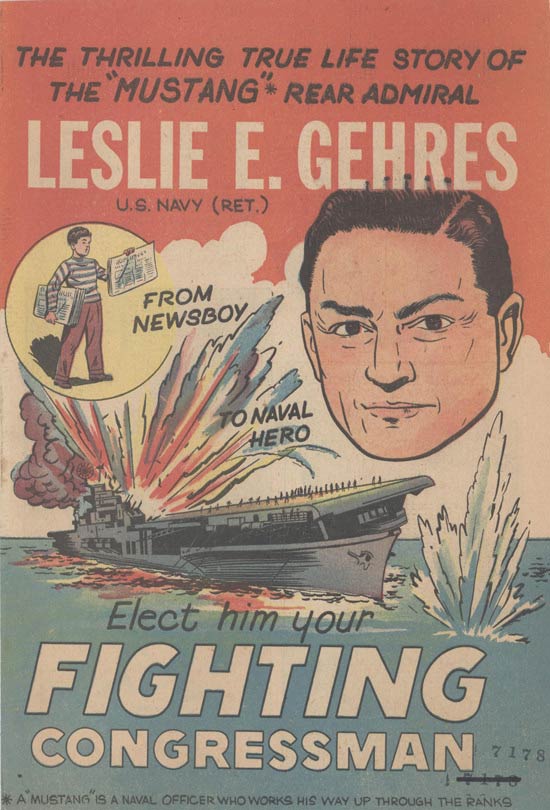 |
Gehres was born on September 23, 1898. After he became a Naval Aviator, he was one of the first aviators to fly off the U.S.S. Langley. Gehres retired from the Navy with the rank of Rear Admiral. He died May 15, 1975.
---o0o---
THIS PAGE UPLOADED: 02/03/12 REVISED:
|











